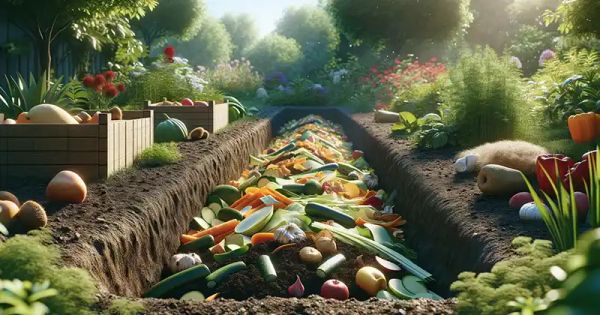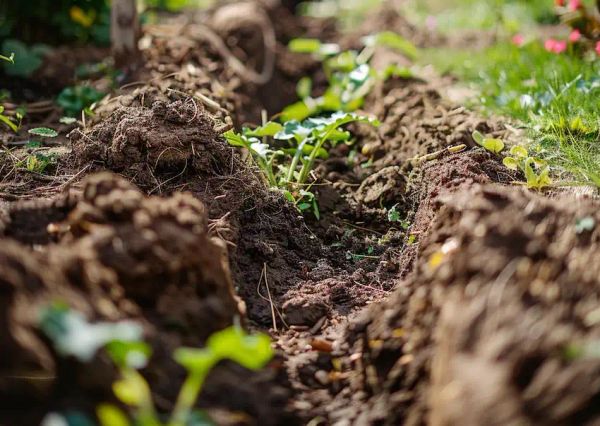Trench composting is a simple and efficient method that can do wonders for your garden soil. By burying organic waste directly in your garden, you can nourish the soil with essential nutrients while minimizing the need for maintenance. In this comprehensive guide, we’ll explore how to trench compost, the benefits it offers, and some additional tips to make the most out of this technique.

How to Trench Compost
Choose the Right Location: Start by selecting a spot in your garden where you plan to grow plants in the future. This is important because trench composting will directly enrich the soil, providing a nutritional boost to your future plants.

Dig the Trench: Next, dig a trench that’s about 12 inches deep. The length and width of the trench can vary based on the amount of compostable material you have, but a standard size could be about 1 foot wide and as long as needed.
Add Your Compost Materials: Fill the trench with organic waste such as kitchen scraps (avoid meat, dairy, and oily foods), garden clippings, leaves, and coffee grounds. For balanced compost, aim for a mix of green (nitrogen-rich) and brown (carbon-rich) materials.
Cover the Trench: Once you’ve added your compost materials, cover them with the soil you dug out. This helps conceal the organic material and speeds up the decomposition process.
Water (If Necessary): If the compost material seems dry, lightly water the area to moisten it. Just make sure not to overwater, as too much moisture can slow down the decomposition process.
Wait and Let Nature Do Its Work: Over time, worms and microorganisms will break down the organic material, transforming it into nutrient-rich soil. The entire process can take anywhere from a few months to a year, depending on the materials used and local soil conditions.
Why Trench Composting is Useful
Improves Soil Health: Trench composting enriches the soil, improving its structure and fertility, which ultimately leads to healthier plant growth and increased yields.
Reduces Waste: By composting kitchen and garden waste, you’re actively reducing the amount of waste sent to landfills, making a positive impact on the environment.
Saves Water: Composted soil retains moisture better than unamended soil, meaning you won’t have to water your garden as frequently.
No Maintenance Required: Unlike traditional compost piles, trench composting doesn’t need turning or maintenance once the organic material is buried. It’s a hassle-free method!
Pest Reduction: Burying compost material helps deter pests that are attracted to above-ground compost piles, making your gardening experience more pleasant.

Additional Tips for Trench Composting
Rotate Composting Areas: To ensure all parts of your garden benefit, rotate your trench composting areas each year. This way, the nutrients are evenly distributed.
Chop or Shred Materials: Organic materials break down faster when they are in smaller pieces. Consider chopping or shredding your compost materials before burying them to speed up the process.
Consider Seasonal Timing: Fall is an excellent season for trench composting since the material will have all winter to decompose, preparing your soil for spring planting. However, you can do trench composting anytime the ground is not frozen.
Layer for Balance: Aim for a good balance between green and brown materials in each trench to promote efficient decomposition.
Trench composting is a fantastic way to recycle organic waste and create nutrient-rich soil for your garden. Whether you’re an experienced gardener or a beginner, trench composting is an easy and rewarding method to enhance your garden’s productivity and sustainability. Share this article with your friends and let them join you on this journey towards a greener and healthier garden!




